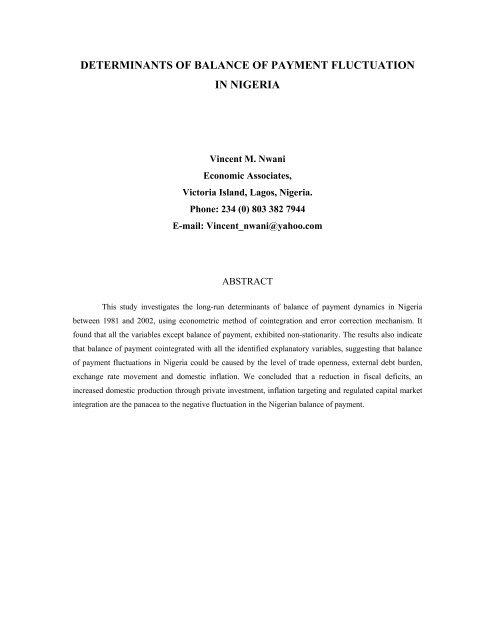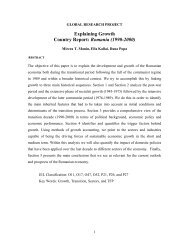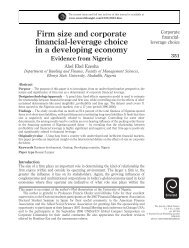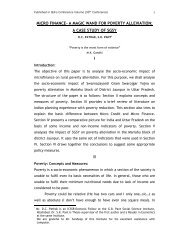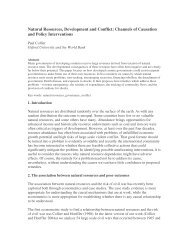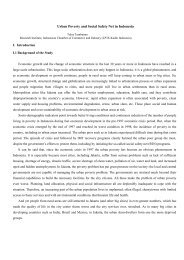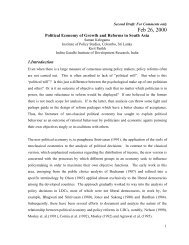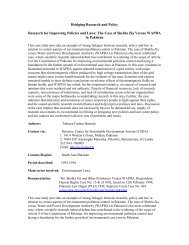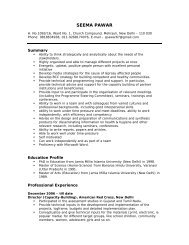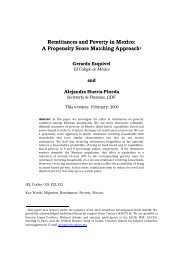determinants of balance of payment fluctuation in nigeria
determinants of balance of payment fluctuation in nigeria
determinants of balance of payment fluctuation in nigeria
You also want an ePaper? Increase the reach of your titles
YUMPU automatically turns print PDFs into web optimized ePapers that Google loves.
DETERMINANTS OF BALANCE OF PAYMENT FLUCTUATION<br />
IN NIGERIA<br />
V<strong>in</strong>cent M. Nwani<br />
Economic Associates,<br />
Victoria Island, Lagos, Nigeria.<br />
Phone: 234 (0) 803 382 7944<br />
E-mail: V<strong>in</strong>cent_nwani@yahoo.com<br />
ABSTRACT<br />
This study <strong>in</strong>vestigates the long-run <strong>determ<strong>in</strong>ants</strong> <strong>of</strong> <strong>balance</strong> <strong>of</strong> <strong>payment</strong> dynamics <strong>in</strong> Nigeria<br />
between 1981 and 2002, us<strong>in</strong>g econometric method <strong>of</strong> co<strong>in</strong>tegration and error correction mechanism. It<br />
found that all the variables except <strong>balance</strong> <strong>of</strong> <strong>payment</strong>, exhibited non-stationarity. The results also <strong>in</strong>dicate<br />
that <strong>balance</strong> <strong>of</strong> <strong>payment</strong> co<strong>in</strong>tegrated with all the identified explanatory variables, suggest<strong>in</strong>g that <strong>balance</strong><br />
<strong>of</strong> <strong>payment</strong> <strong>fluctuation</strong>s <strong>in</strong> Nigeria could be caused by the level <strong>of</strong> trade openness, external debt burden,<br />
exchange rate movement and domestic <strong>in</strong>flation. We concluded that a reduction <strong>in</strong> fiscal deficits, an<br />
<strong>in</strong>creased domestic production through private <strong>in</strong>vestment, <strong>in</strong>flation target<strong>in</strong>g and regulated capital market<br />
<strong>in</strong>tegration are the panacea to the negative <strong>fluctuation</strong> <strong>in</strong> the Nigerian <strong>balance</strong> <strong>of</strong> <strong>payment</strong>.
1. Introduction<br />
Balance <strong>of</strong> <strong>payment</strong> (BOP) is a statistical statement that systematically<br />
summarizes for a specific time period, the economic transaction <strong>of</strong> an economy with the<br />
rest <strong>of</strong> the world. It reflects changes <strong>in</strong> the claims and liabilities <strong>of</strong> an economy vis-à-vis<br />
the rest <strong>of</strong> the world that are ascribed to transactions. Over the last two decades, there has<br />
been grow<strong>in</strong>g trend <strong>in</strong> the <strong>fluctuation</strong>s <strong>of</strong> the Nigerian BOP. We recognize the fact that<br />
quite a lot <strong>of</strong> research has been carried out on the Nigerian BOP, but most <strong>of</strong> these studies<br />
have been at the theoretical level, while others addressed the consequences <strong>of</strong> BOP<br />
deficit. None <strong>of</strong> these studies empirically modeled the long run <strong>determ<strong>in</strong>ants</strong> <strong>of</strong> BOP<br />
<strong>fluctuation</strong>. Moreover, the impact <strong>of</strong> these alleged consequences dur<strong>in</strong>g policy<br />
discussions has led to proposals aimed at attack<strong>in</strong>g these consequences, not the causes <strong>of</strong><br />
BOP <strong>fluctuation</strong>s. This study attempts to cover this gap.<br />
BOP crisis distorts the work<strong>in</strong>gs <strong>of</strong> the entire system (economy) because it creates<br />
disequilibrium between the supply and demand for money. BOP disequilibrium is a<br />
refection <strong>of</strong> disequilibrium <strong>in</strong> the money market (IMF, 2000). Monetary disequilibrium<br />
produces adverse effect on the aggregate expenditure for goods and services (absorption)<br />
<strong>in</strong> the sense that, if the public has an excess supply <strong>of</strong> money it gets rid <strong>of</strong> it by pass<strong>in</strong>g its<br />
excess cash <strong>balance</strong> to foreign countries <strong>in</strong> exchange for goods and services. If the public<br />
desires to keep more money than it has <strong>in</strong> stock, it achieves it by reduc<strong>in</strong>g absorption and<br />
ultimately passes goods and services on <strong>in</strong> foreign countries <strong>in</strong> exchange for money.<br />
The above explanation raises several research questions; what are the causes and<br />
solutions <strong>of</strong> BOP <strong>fluctuation</strong> <strong>in</strong> Nigeria? Does currency depreciation <strong>in</strong>duce relative price<br />
change, rais<strong>in</strong>g the domestic currency price <strong>of</strong> exports and imports and encourag<strong>in</strong>g<br />
resources to move <strong>in</strong>to the traded goods sector? The broad objective <strong>of</strong> this study is<br />
therefore, to f<strong>in</strong>d the long-run causes <strong>of</strong> BOP <strong>fluctuation</strong>s <strong>in</strong> Nigeria and suggest various<br />
ways <strong>of</strong> ameliorat<strong>in</strong>g this recurr<strong>in</strong>g phenomenon. The rest <strong>of</strong> the article is organized <strong>in</strong>to<br />
four sections II conta<strong>in</strong>s the causes and trends <strong>of</strong> BOP <strong>fluctuation</strong>s <strong>in</strong> Nigeria. The<br />
theoretical framework is present <strong>in</strong> section III. The methodology employed and<br />
estimation results are conta<strong>in</strong>ed <strong>in</strong> section IV. Section V concludes with lessons for<br />
policy.<br />
2
2. Determ<strong>in</strong>ants <strong>of</strong> Trend Balance <strong>of</strong> Payment <strong>in</strong> Nigeria<br />
The staff note prepared by the IMF committee on <strong>balance</strong> <strong>of</strong> <strong>payment</strong> statistics<br />
(2000) reports that BOP problems are due to the disequilibrium <strong>in</strong> the physical flows,<br />
namely exports and imports <strong>of</strong> goods and services. Thus it could be analysed on the<br />
basis <strong>of</strong> partial elasticities <strong>of</strong> the exports and imports and the role <strong>of</strong> exchange rate <strong>in</strong> the<br />
adjustments <strong>of</strong> BOP to devaluation. In Nigeria, BOP <strong>fluctuation</strong> is motivated by factors<br />
such as money illusion, terms <strong>of</strong> trade, external debt servic<strong>in</strong>g and exchange rate<br />
(devaluation) movement (Olaloku, 1979). The “time series data” presented <strong>in</strong> table 1<br />
<strong>in</strong>dicates that (BOP) was N-3020.8m (1981), N349.1M (1985), N-5761.5m (1990), N-<br />
195216.3m (1995), N-326635m (1999) and N-565353.3m for 2002.<br />
Table 1 Balance <strong>of</strong> <strong>payment</strong> and some other macroeconomics <strong>in</strong>dicators <strong>in</strong> Nigeria 1981 – 2003<br />
Year BOP<br />
(N’M)<br />
Official<br />
Exchange<br />
Inflatio<br />
n rate<br />
Balance <strong>of</strong><br />
trade (N’M)<br />
Trade<br />
openness<br />
Real<br />
GDP<br />
External<br />
debt<br />
Term <strong>of</strong><br />
trade<br />
Rate<br />
(N/US$)<br />
(%)<br />
growth growth<br />
1981 -3020. 0.63 21.4 -1816.3 0.47 0.01 0.24 329.7<br />
1983 -301.3 0.74 23.2 -1401.2 0.02 -0.05 0.19 345.0<br />
1985 349.1 0.99 5.5 4658.2 0.26 0.00 0.18 300.0<br />
1987 159.2 4.19 10.2 12498.9 0.45 -0.01 1.43 252.3<br />
1989 -22994.2 7.65 40.9 27111.0 0.39 0.07 0.79 187.3<br />
1991 -101407.3 9.70 13.0 34515.2 0.65 0.04 0.09 135.1<br />
1993 -24060.4 22.63 57.2 52669.7 0.55 0.02 0.16 108.2<br />
1995 -195216.3 21.88 72.8 195533.7 0.86 0.02 0.01 100.0<br />
1997 1077.7 21.88 8.5 395946.1 0.73 0.05 -0.035 188.7<br />
1999 -326671.4 92.54 6.6 326499.7 0.38 0.01 3.07 107.6<br />
2000 314139.1 109.55 6.9 982759.4 0.60 0.03 0.20 100.4<br />
2001 24729.9 112.48 18.9 643535.8 0.61 0.03 0.03 104.3<br />
2002 -565353.3 126.4 12.9 302141.0 0.54 0.03 0.19 108.7<br />
2003 -162839.7 135.40 14.0 - 0.48 0.05 0.08 119.3<br />
Sources: (1) Central Bank <strong>of</strong> Nigeria (CBN) Statistical Bullet<strong>in</strong>g 2003, CBN Annual Report and Statement<br />
<strong>of</strong> Accounts (various issues). (2) Columns 6, 7 and 8 are computed by the authors.<br />
3
Figure1.<br />
BOP Dynamics <strong>in</strong> Nigeria (1980-2003)<br />
400000<br />
200000<br />
0<br />
-200000<br />
1981<br />
1983<br />
1985<br />
1987<br />
1989<br />
1991<br />
1993<br />
1995<br />
1997<br />
1999<br />
2001<br />
2003<br />
BOP (N’M)<br />
-400000<br />
-600000<br />
-800000<br />
In an attempt to identify the long-term causes <strong>of</strong> BOP <strong>fluctuation</strong> <strong>in</strong> Nigeria, the<br />
vulnerability <strong>of</strong> the economy to external shocks, external debt burden and debt servic<strong>in</strong>g<br />
issues, <strong>in</strong>flationary effects, trade openness and exchange rate movements have rema<strong>in</strong>ed<br />
the focal issues. BOP adjustment through exchange rate changes relies upon the effect <strong>of</strong><br />
the relative prices <strong>of</strong> domestic and foreign goods on the trade flows with the rest <strong>of</strong> the<br />
world (Thrillwall, 2004). This relative price, or terms <strong>of</strong> trade is def<strong>in</strong>ed by the ratio <strong>of</strong><br />
export and import prices <strong>in</strong> domestic currency from the po<strong>in</strong>t <strong>of</strong> view <strong>of</strong> the country as a<br />
whole, the terms <strong>of</strong> trade represents the amount <strong>of</strong> imports that can be obta<strong>in</strong>ed <strong>in</strong><br />
exchange for a unit <strong>of</strong> exports<br />
or the amount <strong>of</strong> exports required to obta<strong>in</strong> one unit <strong>of</strong><br />
imports. The terms <strong>of</strong> trade may vary both because <strong>of</strong> change <strong>in</strong> the prices expressed <strong>in</strong><br />
the respective national currencies and because <strong>of</strong> exchange rate changes. Thrillwall<br />
(2004) noted that depreciation <strong>in</strong> the exchange rate at unchanged domestic and foreign<br />
prices <strong>in</strong> the respective currencies makes domestic goods cheaper <strong>in</strong> the foreign markets<br />
and foreign goods more expensive <strong>in</strong> the domestic market.<br />
Soderstan (1989) contents that devaluation tends to make imports more expensive<br />
<strong>in</strong> domestic currency terms, which are not matched by a correspond<strong>in</strong>g rise <strong>in</strong> export<br />
prices. This implies that the terms <strong>of</strong> trade will deteriorate. Deterioration <strong>in</strong> the terms <strong>of</strong><br />
4
trade represents a loss <strong>of</strong> real national <strong>in</strong>come and can lead to BOP crisis because more<br />
units <strong>of</strong> exports have to be given to obta<strong>in</strong> one unit <strong>of</strong> imports. Hence, the terms <strong>of</strong> trade<br />
effects caused by devaluation lowers <strong>in</strong>come. A devaluation <strong>of</strong> currency causes an<br />
<strong>in</strong>crease <strong>in</strong> the import prices and general price level. This <strong>in</strong>itiates reduction <strong>in</strong> the real<br />
value <strong>of</strong> wealth held <strong>in</strong> monetary form such that the real value <strong>of</strong> cash <strong>balance</strong> is reduced<br />
lead<strong>in</strong>g to unfavourable BOP.<br />
Chachodiades (1978) ma<strong>in</strong>ta<strong>in</strong>ed that money illusion and expectation effects can<br />
<strong>in</strong>duce BOP <strong>fluctuation</strong> because real <strong>in</strong>come does not change due to proportionate<br />
<strong>in</strong>crease <strong>of</strong> price and money <strong>in</strong>come. The direction <strong>of</strong> the change depends on the type <strong>of</strong><br />
money illusion. Money illusion <strong>in</strong>hibits real activities though these effects are significant<br />
only at the short run. Therefore, if people are unconscious <strong>of</strong> the work<strong>in</strong>gs <strong>of</strong> money<br />
illusion, they will likely change their absorption. It is possible that economic agents <strong>in</strong><br />
Nigeria regard the <strong>in</strong>crease <strong>in</strong> prices <strong>in</strong>duced by currency devaluation as likely to spark<br />
further price rises. This has consequently resulted to an <strong>in</strong>crease <strong>in</strong> direct absorption,<br />
which has worsened the country’s <strong>balance</strong> <strong>of</strong> <strong>payment</strong>s.<br />
Nigerian external debt burden and external debt servic<strong>in</strong>g over the last two and<br />
half decades has been blamed by several authors for the negative pr<strong>of</strong>ile <strong>of</strong> the country’s<br />
BOP. Dell and Lawrence (1980) stressed that a potential and <strong>in</strong>creas<strong>in</strong>gly significant<br />
source <strong>of</strong> demand deflation, which might be <strong>in</strong>duced by currency depreciation <strong>in</strong><br />
develop<strong>in</strong>g countries, arises from its effects on debt servic<strong>in</strong>g. Clearly, the Nigerian<br />
external debt obligation is large and the <strong>in</strong>terest payable keeps ris<strong>in</strong>g over years. The<br />
implication <strong>of</strong> this circumstance is that debt service expenditure reduces wealth and the<br />
resource available to improve the country’s real activities, which is detrimental to BOP.<br />
Inflationary effects caused by currency depreciation might be expected to have an<br />
expenditure reduc<strong>in</strong>g impact (Dornbusch, 1992). Reduction <strong>in</strong> real expenditure will occur<br />
only if the appropriate monetary policy is simultaneously pursued (Fakiyesi, 1996). But<br />
over years, <strong>in</strong>flation policies and targets <strong>in</strong> Nigeria has failed to achieve its desired<br />
objectives <strong>of</strong> correct<strong>in</strong>g BOP disequilibrium due to misspecification <strong>of</strong> macroeconomic<br />
policies and <strong>in</strong>sufficient time lag. The monetary approach to the <strong>balance</strong> <strong>of</strong> <strong>payment</strong> sees<br />
the monetary implications <strong>of</strong> exchange rate depreciation as be<strong>in</strong>g absolutely crucial. But<br />
depreciation becomes unnecessary provided sufficient time (that is f<strong>in</strong>anc<strong>in</strong>g) is available<br />
5
for automatic correction to occur. Accord<strong>in</strong>g to this approach the mechanism by which<br />
depreciation affects the BOP is by rais<strong>in</strong>g the domestic price level and thereby <strong>in</strong>creas<strong>in</strong>g<br />
the demand for nom<strong>in</strong>al money <strong>balance</strong>s (Ikhide, 1993).<br />
The messages from the review above are many. First BOP can be caused by many<br />
factors, notably, monetary, fiscal and structure <strong>of</strong> factors. Second, <strong>in</strong> an economy like<br />
Nigeria that is already beset with trend unfavourable <strong>balance</strong> <strong>of</strong> <strong>payment</strong> (BOP). It would<br />
appear more reasonable to look <strong>in</strong>to the long run <strong>determ<strong>in</strong>ants</strong> <strong>of</strong> BOP rather than the<br />
short run causes. F<strong>in</strong>ally, it would be better to <strong>in</strong>corporate all the possible factors <strong>in</strong>to one<br />
model and disaggregate the variables to identify the exact po<strong>in</strong>ts that deserve attention.<br />
6
3. Theoretical Framework<br />
A theoretical rational for the BOP variability is the disequilibrium between<br />
domestic <strong>in</strong>come and expenditure. The absorption approach focuses on the fact that<br />
current account im<strong>balance</strong>s can be viewed as the difference between domestic output and<br />
domestic spend<strong>in</strong>g (absorption).<br />
A = X– M – Y – A ……………….. (1)<br />
Understand<strong>in</strong>g how devaluation affects both <strong>in</strong>come and absorption is therefore<br />
central to the absorption approach to the <strong>balance</strong> <strong>of</strong> <strong>payment</strong>s. If devaluation raises<br />
domestic <strong>in</strong>come relative to domestic spend<strong>in</strong>g the current account will improve. Machup<br />
(1960) formalized this possibility <strong>in</strong> his article “Balance <strong>of</strong> <strong>payment</strong>s and the so called<br />
dollar shortage”. He stated that if devaluation raises domestic absorption relative to<br />
domestic <strong>in</strong>come the current account will deteriorate. Machup assumes that if the<br />
economy is below the full employment level, then there will be an <strong>in</strong>crease <strong>in</strong> net exports<br />
follow<strong>in</strong>g devaluation. It is however not clear whether the employment effect will raise or<br />
lower national <strong>in</strong>come.<br />
The elasticity approach holds that BOP problems are due to disequilibrium <strong>in</strong> the<br />
physical trade flows namely export and imports <strong>of</strong> goods and services. This approach can<br />
be analyzed on the basis <strong>of</strong> partial elasticities <strong>of</strong> the exports and imports and the rate <strong>of</strong><br />
exchange rate <strong>in</strong> the adjustment <strong>of</strong> BOP to currency devaluation. Thrillwall (2004)<br />
showed that there are two direct effects <strong>of</strong> exchange rate changes on the <strong>balance</strong> on goods<br />
and services.<br />
• The <strong>in</strong>creases <strong>in</strong> the volume (Volume effect) <strong>of</strong> exports due to the <strong>in</strong>crease <strong>in</strong><br />
the price competitiveness <strong>of</strong> the exports and the decrease <strong>in</strong> the volume <strong>of</strong><br />
imports due to the decrease <strong>in</strong> the price competitiveness <strong>of</strong> imports subject to<br />
the devaluation. The volume effect clearly contributes to improv<strong>in</strong>g the goods<br />
and services account.<br />
• Due to the devaluation (Price effect) exports become cheaper measured <strong>in</strong><br />
foreign currency and imports become more expensive measured <strong>in</strong> domestic<br />
currency. The price effect clearly contributes to the worsen<strong>in</strong>g <strong>of</strong> the goods<br />
and services account.<br />
7
If the suitable conditions on the elasticities are fulfilled the <strong>balance</strong> <strong>of</strong> <strong>payment</strong>s ought to<br />
improve. However, it may happen that quantities do not adjust as quickly as prices,<br />
ow<strong>in</strong>g to frictions and reaction lags <strong>of</strong> both consumers and <strong>in</strong>vestors; it takes time for<br />
consumers <strong>in</strong> both devalu<strong>in</strong>g country and the rest <strong>of</strong> the world to respond to the changed<br />
competitive situation. Due to these facts the <strong>balance</strong> <strong>of</strong> <strong>payment</strong>s may aga<strong>in</strong> deteriorate<br />
before improv<strong>in</strong>g towards the new equilibrium po<strong>in</strong>ts.<br />
(Quantity adjustment periodic is def<strong>in</strong>ed as the period <strong>in</strong> which both quantities and<br />
prices can changes)<br />
Adopt<strong>in</strong>g the general framework <strong>of</strong> BOP as described by Kallon (1994), the<br />
simple open-economy LM model is employed to derive the long-run BOP equation. The<br />
equation is <strong>of</strong> the form:<br />
Y t =<br />
∝ 1 r t + ∝ 2 g t + ∝ 3 P f t + ∝ 4 Y t-1 (∝ 1 0)……………………….(2)<br />
Where equation (2) is the commodity market equilibrium, which is assumed to<br />
depend on the domestic <strong>in</strong>terest rate (r), level <strong>of</strong> government spend<strong>in</strong>g (g), the<br />
relative price <strong>of</strong> imported goods (P f ) and the real <strong>in</strong>come (Y) <strong>of</strong> the previous year.<br />
On the other hand the money market equilibrium (LM) equation is <strong>of</strong> the form:<br />
M t = B 1 Y t + B 2 Y t + B 3 Op t (B 1 >0, B 2 , B 3
The search for a reliable BOP function cont<strong>in</strong>ues to be an <strong>in</strong>tensive activity. In<br />
Nigeria, very little is known about the contemporary relationship between BOP and other<br />
macroeconomics variables. The BOP function adopted <strong>in</strong> this study, therefore, comb<strong>in</strong>es<br />
the structuralist, monetarist, and fiscalist approaches. Given the structure <strong>of</strong> the Nigerian<br />
economy s<strong>in</strong>ce f<strong>in</strong>ancial deregulation and trade liberalization, (1985 – 1986) as well as<br />
volum<strong>in</strong>ous empirical evidence on Nigerian and other nations <strong>of</strong> the world, we specify<br />
the follow<strong>in</strong>g long –run BOP function.<br />
BOP = ∝ o + ∝ 1 EXR t + ∝ 2 INF t + ∝ 3 BOT t + ∝ 4 TOP t + ∝ 5 Y t + ∝ t<br />
EXD t + ∝ 7 TOT t + U t ………………. (5)<br />
Where BOP = Balance <strong>of</strong> <strong>payment</strong>, EXR = Exchange rate (N/$), TOT = Term <strong>of</strong> trade,<br />
BOT = Balance <strong>of</strong> trade (Export – Import), TOP = Trade Openness (Total trade/Norm<strong>in</strong>al<br />
EDP), Y = Real GDP Growth, EXD = External Debt Growth, U = White noise error<br />
term.<br />
Yearly, data were used to estimate equation (5) above and the estimation sample<br />
is 1980 through 2003. All the time series data employed were gathered from CBN<br />
publications such as monthly and annual reports and statistical bullet<strong>in</strong> (for various years)<br />
and augmented by relevant publications <strong>of</strong> the Federal Office <strong>of</strong> Statistics (FOS) and the<br />
<strong>in</strong>ternational f<strong>in</strong>ancial statistics <strong>of</strong> the IMF.<br />
The ma<strong>in</strong> question here is whether macro economic variables such as BOP,<br />
exchange rate, <strong>in</strong>flation rate, external debt, prices and so on, ma<strong>in</strong>ta<strong>in</strong> a long-run trend<br />
follow<strong>in</strong>g a shock, or do they follow a random work? The essence <strong>of</strong> this question is that<br />
if these variables follow random works or have different orders <strong>of</strong> <strong>in</strong>tegration a<br />
regression <strong>of</strong> one variable aga<strong>in</strong>st other variables can lead to spurious results s<strong>in</strong>ce the<br />
OLS estimates would def<strong>in</strong>itely not yield consistent parameter estimates. Therefore, the<br />
requirement, <strong>in</strong> model<strong>in</strong>g BOP, is an approach that captures the long run relationship<br />
between the variables while avoid<strong>in</strong>g spurious <strong>in</strong>ferences. Both the Augmented Dickey –<br />
Fuller (ADF) and Phillips Peron (PP) unit root tests were employed to determ<strong>in</strong>e the<br />
order <strong>of</strong> each series. The critical t value for ADF tests was chosen by the Akaike (AIC)<br />
9
f<strong>in</strong>al prediction Error (FPE) criterion while PP tests are estimated for alternative Bartlett<br />
Karmeel truncation lags.<br />
In the event <strong>of</strong> non-stationarity <strong>in</strong> the series, we then conduct co<strong>in</strong>tegration tests.<br />
The implication beh<strong>in</strong>d this series <strong>of</strong> tests is that if each time series is non-stationary,<br />
l<strong>in</strong>ear comb<strong>in</strong>ations <strong>of</strong> such time series that are stationary might exist. In that case,<br />
multiple times series are co<strong>in</strong>tegrated and share some common stochastic trends. We can<br />
<strong>in</strong>terpret the presence <strong>of</strong> co<strong>in</strong>tegration to imply that the long run movements <strong>in</strong> these<br />
multiple time series are related to each other. Indeed, if there is a long-run relationship<br />
between two or more non-stationary variables then the general concept <strong>of</strong> co<strong>in</strong>tegration is<br />
that deviations from this long run path are stationary. If this is the case, the variables <strong>in</strong><br />
question are said to be co<strong>in</strong>tegrated. A time series can however, only be co<strong>in</strong>tegrated if it<br />
is <strong>in</strong>tegrated <strong>of</strong> the same order (Eagle and Granger, 1987).<br />
The fact that variables are co<strong>in</strong>tegrated implies that there is an adjustment<br />
process, which prevents errors <strong>in</strong> the long run, relationship from becom<strong>in</strong>g larger and<br />
larger. Engle and Granger (1991) have shown that any co<strong>in</strong>tegration series has an error<br />
correlation presentation, suggest<strong>in</strong>g that co<strong>in</strong>tegration is a necessary condition for an<br />
error correction model (ECM) to hold. Hylleberg and Mizon (1989) and Philips and<br />
Lovetan (1991) have given a detailed analysis <strong>of</strong> co<strong>in</strong>tegration and error correction<br />
mechanism. Indeed, such models <strong>in</strong>corporate both the economic theory relat<strong>in</strong>g to the<br />
long run relationship between variables and short run disequilibrium behaviours.<br />
The start<strong>in</strong>g po<strong>in</strong>t <strong>of</strong> ECM is a test aga<strong>in</strong>st the null hypothesis that the residuals <strong>of</strong><br />
the long run (static) model are non-stationary. Here, we apply ADF tests to the residuals<br />
<strong>of</strong> the static co<strong>in</strong>tegration regressions. The evidence <strong>of</strong> stationarity <strong>of</strong> the residuals<br />
<strong>in</strong>dicates that the variables <strong>in</strong> the model are <strong>in</strong>deed co<strong>in</strong>tegrated. The next move is to<br />
switch to a short run model with an error correction mechanism. Adopt<strong>in</strong>g the Engel-<br />
Granger representation, we employ an error correction dynamic specification <strong>of</strong> the form.<br />
∆BOP t = ∝ o + ∝ 1 L (∆Z) - ∝ 2 ECM t-1 + e t …………. (7)<br />
10
Where Z is the vector <strong>of</strong> variables that co<strong>in</strong>tegrate with BOP, L is a general lag operator<br />
and ECM is the time series <strong>of</strong> residuals from the co<strong>in</strong>tegrat<strong>in</strong>g vector.<br />
Equation (7) <strong>in</strong>corporates a corrective mechanism by which previous<br />
disequilibrium <strong>in</strong> the relationship between the level <strong>of</strong> BOP and the level <strong>of</strong> one or more<br />
<strong>determ<strong>in</strong>ants</strong> are permitted to affect current change <strong>in</strong> BOP. In this way, an allowance is<br />
made for any short run divergence <strong>in</strong> BOP from its long run trend. Equation (7) can then<br />
be reduced to a parsimonious equation through the elim<strong>in</strong>ation <strong>of</strong> <strong>in</strong>significant terms and<br />
the imposition <strong>of</strong> constra<strong>in</strong>ts that holds a reasonable approximation (see Adam, 1992 and<br />
Bougton, 1991).<br />
4. Model Results and Discussion<br />
4.1 Unit Root Tests<br />
Previous evidence consider<strong>in</strong>g the stationarity <strong>of</strong> some macro economic variables <strong>in</strong><br />
Nigeria provided mixed results. For <strong>in</strong>stance, Folorunsho and Abiola (2000) showed that<br />
<strong>in</strong>flation, exchange rate and real GDP <strong>in</strong> Nigeria between 1970 and 1998 are stationary at<br />
levels. Ariyo (2004) discovered that over the period (1970 – 2001, Balance <strong>of</strong> <strong>payment</strong> is<br />
stationary, but over a shorter sub period (1986 – 2001) the Augmented Dickey Fuller test<br />
cannot reject the unit root –null hypothesis. Table 2 presents the ADF results with the<br />
evidence that <strong>balance</strong> <strong>of</strong> <strong>payment</strong>s, <strong>balance</strong> <strong>of</strong> trade, external debt growth, exchange rate<br />
and real GDP series are stationary at their levels 1(0), while other variables <strong>in</strong> our model<br />
assumed stationarity at their first difference 1(1). Also, the PP unit root results presented<br />
<strong>in</strong> Table 3 provides that <strong>balance</strong> <strong>of</strong> <strong>payment</strong>, <strong>balance</strong> <strong>of</strong> trade, external debt growth and<br />
<strong>in</strong>flation series are stationary at their levels, While other variables <strong>in</strong> our model are<br />
stationary at their differences. Thus, the method suggested by Evans (1991) to decompose<br />
macro economic variables <strong>in</strong>to long run and short run components based upon the<br />
11
assumption <strong>of</strong> unit root <strong>in</strong> the level <strong>of</strong> macroeconomic variables are applicable to this<br />
sample.<br />
Table 2. Augmented Dickey Fuller (ADF) Unit Root Tests<br />
Variables T - statistics P. values Remark<br />
Levels Differences<br />
BOP -11.0481 * 0.00 1 (0)<br />
BOT -6.04591 * 0.00 1 (0)<br />
ExD -1.36839 -10.815 * 0.00 1(1)<br />
ExDG -5.01357 * 0.00 1(0)<br />
ExR -5.20405 * 0.00 1(0)<br />
INF -2.33505 -4.63872 * 0.07 1(1)<br />
TOP -0.83412 -5.04206 * 0.04 1(1)<br />
TOT -1.58857 -493488 * 0.02 1(1)<br />
Y -4.17209 * 0.01 1(0)<br />
Note: one star implies significance at 1% (critical value = 4.49831).<br />
Table 3. Philips Perron (PP) Unit Root Tests<br />
Variables T - statistics P. values Remark<br />
Levels Differences<br />
BOP -3.22995* 0.03 1 (0)<br />
BOT -4.19446*** 0.01 1 (0)<br />
ExD -0.47767 -4.22065** 0.01 1(1)<br />
ExDG -5.02412* 0.00 1(0)<br />
ExR -1.35243 -8.31185* 0.00 1(2)<br />
INF -2.34651 -5.85384* 0.00 1(1)<br />
TOP -3.2899*** 0.09 1(0)<br />
TOT -1.57315 -8.42084* 0.00 1(1)<br />
Y -3.07864 -11.0368* 0.00 1(2)<br />
Note: One star implies significance at 1% (critical value = -4.4679), two stars implies<br />
significance at 5% (critical value = -3.64496) and three stars implies significance at 10% (critical<br />
value = -3.26145).<br />
Follow<strong>in</strong>g our f<strong>in</strong>d<strong>in</strong>gs <strong>in</strong> section 4.1 that all the variables <strong>of</strong> <strong>in</strong>terest are<br />
stationary at difference {i.e.1(1) and I(2)} except for BOP, we tested for possible<br />
12
co<strong>in</strong>tegration among these variables. Adopt<strong>in</strong>g Engle and Granger’s two-step method, we<br />
first estimated the long-run relation <strong>of</strong> these variables with BOP by OLS and then tested<br />
for the stationary <strong>of</strong> the residuals. We found that there is a long-run relationship between<br />
BOP and its <strong>determ<strong>in</strong>ants</strong> through the stationarity {1(0)} <strong>of</strong> the residual series at its<br />
levels. The OLS estimations result and summary statistics is presented <strong>in</strong> table 4.<br />
Table 4: OLS Estimation Results and Summary statistics <strong>of</strong> BOP model Eq. (5).<br />
Variables Coefficient STD error T-statistics Probability<br />
Constant 2028607 534412.4 3.795 0.00<br />
BOT 0.743 0.049 6.597 0.00<br />
EXD -0.061 25714.7 -1.2445 0.23<br />
EXDG -47901.7 9987.6 -1.862 0.08<br />
EXR -14222.2 1202.6 -1.932 0.027<br />
INF -4262.6 180323.8 -3.544 0.00<br />
TOP -207463 594.8 -1.15 0.27<br />
TOT 1874.2 6.143 3.15 0.00<br />
Y 18.731 6.559 2.855 0.01<br />
Note: R 2 = 0.83, F = 8.06, DW = 1.61, Observation =22.<br />
The co<strong>in</strong>tegration results reported <strong>in</strong> table 5 <strong>in</strong>dicate that all the variables <strong>in</strong> our<br />
model are co<strong>in</strong>tegrated with BOP. It was noted that the lagged series <strong>of</strong> the explanatory<br />
variables did not survive the result<strong>in</strong>g Schwarz <strong>in</strong>formation criterion (not statistically<br />
significant). We observed that both the residual and its lagged series (ECM and ECM1)<br />
proved statistically significant. This further confirms the long-run relationship between<br />
BOP and all the tested <strong>determ<strong>in</strong>ants</strong>. The co<strong>in</strong>tegration result is presented <strong>in</strong> table 5.<br />
13
Table 5: Co<strong>in</strong>tegration results (Model<strong>in</strong>g BOP by Engle and Granger’s Two –step method)<br />
Variables Coefficients STD Error T-value P-value<br />
Constant -1184897 106415 -3.31 0.00<br />
BOT 0.743 1.29 5.75 0.00<br />
BOT 1 0.196 0.156 1.254 0.256<br />
BOT 2 -0.826 0.182 -4.53 0.004<br />
EXD -0.061 5.63 -9.01 0.00<br />
EXD1 1286.9 376.52 0.034 0.973<br />
EXD2 -2382.8 36838 -0.646 0.541<br />
EXDG -47901 2.95 -6.21 0.00<br />
EXDG 1 0.284 0.493 0.577 0.421<br />
EXDG 2 0.811 0.448 0.634 0.389<br />
EXR -1422 1.15 2.41 0.00<br />
EXR 1 1725 1629 1.059 0.33<br />
EXR 2 -11576 14175 -0.816 0.445<br />
INF -4262 1.38 -3.09 0.00<br />
INF 1 -1135 1586 -0.714 0.501<br />
INF 2 353.6 1555 0.227 0.827<br />
TOP -207.4 2.07 -3 0.00<br />
TOP 1 0.193 3.271 1.13 0.541<br />
TOP 2 -0.384 5.86 -0.691 0.32<br />
TOT 1674 6.83 2.75 0.00<br />
TOT 1 1867 1127 1.656 0.14<br />
TOT 2 382.8 1056 0.362 0.72<br />
Y 18.73 7.53 2.49 0.00<br />
Y 1 10.64 12.34 0.862 0.729<br />
Y 2 -2.68 11.02 -0.243 0.421<br />
Note: R2 = 0.931, F = 6.263, DW = 2.596, SE = 0.090 Information criteria: SC = -2.14, FPE = -0.147.<br />
ECM Result<br />
Variables Coefficients STD Error T-value P-value<br />
ECM -0.41 0.44 -2.439 0.073<br />
ECM 1 -0.3 0.114 -2.635 0.099<br />
The results presented <strong>in</strong> table 5 clearly <strong>in</strong>dicates a well-def<strong>in</strong>ed error correction<br />
term ECM t-1 and ECM t which <strong>in</strong>dicates a feedback 0.30 and 0.41 <strong>of</strong> the previous and<br />
current year’s disequilibrium from the long-run elasticities <strong>of</strong> the identified variables that<br />
courses the <strong>fluctuation</strong> <strong>of</strong> BOP. The empirical evidence shows that these variables<br />
14
provide explanation for the <strong>fluctuation</strong> <strong>of</strong> BOP <strong>in</strong> Nigeria through time. The effect <strong>of</strong> this<br />
error correction is not only large but also exhibited a negative <strong>in</strong>fluence as expected at 1<br />
per cent level <strong>of</strong> significance. The constant coefficients <strong>of</strong> the variables also reveal that<br />
exchange rate, external debt, <strong>in</strong>flation and trade openness relates negatively with BOP<br />
over time <strong>in</strong> Nigeria. Conversely, <strong>balance</strong> <strong>of</strong> trade, term <strong>of</strong> trade and real GDP<br />
ma<strong>in</strong>ta<strong>in</strong>ed a positive relationship with BOP dur<strong>in</strong>g the sample period.<br />
5. Conclusion and Policy Lessons<br />
Results from our empirical analysis provide support for the unit root alternative<br />
hypothesis hence these variables are non-stationary except for BOP, and <strong>in</strong>deed, they are<br />
<strong>of</strong> random walk. Given the non-stationarity <strong>of</strong> these series, the co<strong>in</strong>tegration equation was<br />
estimated. The evidence confirms that <strong>balance</strong> <strong>of</strong> <strong>payment</strong> co<strong>in</strong>tegrates with exchange<br />
rate, <strong>balance</strong> <strong>of</strong> trade, term <strong>of</strong> trade, <strong>in</strong>flation rate, real GDP, external debt and trade<br />
openness.<br />
In order to put the Nigerian economy on the path <strong>of</strong> susta<strong>in</strong>able growth and<br />
development as well as reduce <strong>balance</strong> <strong>of</strong> <strong>payment</strong> <strong>fluctuation</strong>s, the government has to<br />
reduce fiscal deficits, encourage<br />
private <strong>in</strong>vestment, target <strong>in</strong>flation and address the<br />
perennial external debt problem. Bear<strong>in</strong>g <strong>in</strong> m<strong>in</strong>d both, the practical problems associated<br />
with exchange controls, it seems reasonable to conclude that while exchange rate<br />
devaluation may <strong>in</strong> some cases, provide a useful short run tourniquet <strong>in</strong> the event <strong>of</strong> a<br />
<strong>balance</strong> <strong>of</strong> <strong>payment</strong>s crisis, they do not generally <strong>of</strong>fer a cost effective measure <strong>of</strong><br />
correct<strong>in</strong>g deficits. Indeed their pr<strong>in</strong>cipal effect is adverse and suppresses imports rather<br />
than the positive one <strong>of</strong> encourag<strong>in</strong>g exports.<br />
15
REFERENCES<br />
Adam, C. S. (1992) Recent Developments <strong>in</strong> Econometric Methods: An Application<br />
to the Demand for Money <strong>in</strong> Kenya, African Economic Research<br />
consortium, AERC special papers, 15, Pp. 1- 52.<br />
Boughton, J. M. (1991), Long run Money demand <strong>in</strong> Large Industrial Countries, IMF<br />
staff papers 38; Pp. 1 – 32.<br />
CBN Annual reports (various issues)<br />
CBN statistical Bullet<strong>in</strong> (2002)<br />
Chachodiades, M. (1978), International Monetary Theory and Policy, New York,<br />
Mcgraw Hill.<br />
Dell A. and R. Lawrence (1980), Balance <strong>of</strong> Payments Adjustment process <strong>in</strong> develop<strong>in</strong>g<br />
countries (New York: Pergoman)<br />
Dornbusch, R. I (1992) Lessons from Experiences with High Inflation, The World Bank<br />
Economic Review 6(1)<br />
Engel, R. F. and C. W. J. Granger (1987), Co<strong>in</strong>tegration and Error-correction:<br />
Representation, Estimation and Test<strong>in</strong>g, Econometrics 55, Pp. 251 –76.<br />
Engel, R. F. and C.W.J. Granger (1991), Long run Economics Relations: Read<strong>in</strong>gs <strong>in</strong><br />
co<strong>in</strong>tegration, Oxford University Press London.<br />
Fakiyesi, T. O. (1996), Further empirical analysis <strong>of</strong> <strong>in</strong>flation <strong>in</strong> Nigeria, CBN Economic<br />
and F<strong>in</strong>ancial Review 34 (1), Pp. 489- 499.<br />
Hylleberg, S. and G. F. Mizan (1989) co<strong>in</strong>tegration and Error Correction Mechanism,<br />
The Economic Journal, 99, Pp.113 – 125.<br />
Ikhide, S. I (1993) F<strong>in</strong>ancial Liberalization and the Inflationary process; is there a<br />
l<strong>in</strong>k <strong>in</strong> Adjust<strong>in</strong>g Develop<strong>in</strong>g Countries? International Review <strong>of</strong> Economic<br />
and Bus<strong>in</strong>ess, 40, Pp. 157 – 174<br />
IMF (2000), Tra<strong>in</strong><strong>in</strong>g <strong>in</strong> the use <strong>of</strong> Balance <strong>of</strong> Payments Statistics – staff notes,<br />
Thirteenth meet<strong>in</strong>g <strong>of</strong> the IMF committee on Balance <strong>of</strong> Payments Statitistics,<br />
Wash<strong>in</strong>gton, D.C. October 23 – 27, 2000.<br />
Kallon, K. M. (1994), An econometrics analysis <strong>of</strong> <strong>in</strong>flation <strong>in</strong> Sierra Leon, Journal <strong>of</strong><br />
African Econometrics, 3 (2), Pp. 199 – 230.<br />
16
Machup, F. (1960), Three Concepts <strong>of</strong> Balance <strong>of</strong> Payments and the so-called Dollar<br />
shortage, Economic Journal Vol. LX March, Pp.46 – 68.<br />
Olaloku, F. A. (1979), structure <strong>of</strong> the Nigerian Economy, Lagos Macmillans<br />
Soderstan, R. O. (1989), International Economics, New York, Harper and Row, PP. 226<br />
– 241,<br />
Thrillwall, A.P.(2004), Trade ,Balance <strong>of</strong> Payments and Exchange Rate Policy In<br />
Develop<strong>in</strong>g Countries, Edward Edger Publish<strong>in</strong>g, UK.<br />
17


